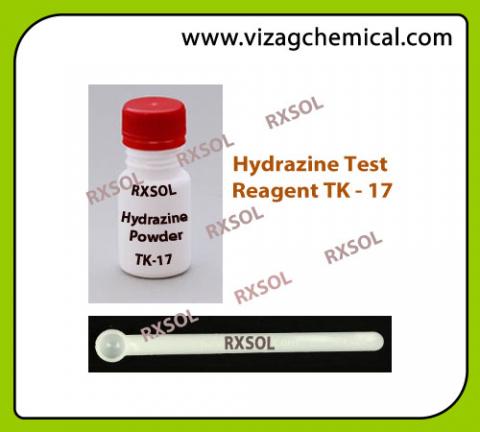Primary tabs

Hydrazine Test Reagent TK-17
Reagent of Hydrazine Test Kit powder
HYDRAZINE TEST POWDER TK-17
Colorimetric Procedure
The objective is to maintain a hydrazine residual between 0.05-0.2 ppm depending on operating pressure and boiler designe. Actual consumption is determined under operating conditions. A normal dosage is approximately 1 ltr. per day, depending of system layout.
Hydrazine is a convenient reductant because the by-products are typically nitrogen gas and water. Thus, it is used as an ANTIOXIDANT, an oxygen scavenger, and a corrosion inhibitor in water boilers and heating systems.
Hydrazine is mainly used as a foaming agent in preparing polymer foams.
No oxygen is entering the boiler with the feed water when hydrazine is present in the water.
Directions for use : Based on Colorimetric Procedure
1. Take 5 ml of sample to be tested in the Test jar.
2. Add 40 drop (2ml) of Reagent TK-16. Mix wel
3. Add 2 micro spoon full of Reagent TK-17. Mix well upto provider dissolves Completely. Wait for 10 minutes.
4. Now rinse the empty comparator tube with above solution and will upto the half level of the comparator tube.
5. Insert this tube in sample slot of comparator.
6. Compare the developed colour with standard comparator colours.
7. Note down the ppm level of Hydrazine as N2H4
Note 1 ::: Studies showed that hydrazine was not stable on the sampling device, therefore, immediate extraction of samples after collection was recommended.
Note 2 ::: color is stable for 1 hours.
Sample of Hydrazine is Harmful. Handle with due care.
All open chemicals should be used only in a fume hood.
Avoid any skin contact with all chemicals. Immediately flush contaminated areas with copious amounts of water.
Wear safety glasses at all times.
Always try to keep HYDRAZINE level at minimum level. As by the decomposition of hydrazine ammonia will be liberated and Ammonia in the presence of oxygen is corrosive to copper and copper alloys.
It will be necessary to test the hydrazine residuals in the boiler daily in order to obtain complete protection with minimum doses of hydrazine. If the hydrazine residual in the boiler is over 0.1 PPM, reduce the dosage of hydrazine until the boiler hydrazine residual falls below the recommended maximum of 0.1 PPM. If the hydrazine residual does not immediately drop below the 0.1 PPM level, the boiler should be blowdown to reduce the hydrazine level. New boilers, or those recently open for inspection and repair, may take several weeks to achieve a normal boiler hydrazine residual due to oxides. This is normal, and until a hydrazine residual is obtained in the boiler water, test the feed water for the hydrazine content. Maintain the hydrazine reading in the feed water between 0.02 and 0.03 PPM. No oxygen is entering the boiler with the feed water when hydrazine is present in the water. hydrazine may be dosed into the feed pump suction, more preferably, to the storage section of the deaerator, which will maximize the residence and reaction time. A separate dosing tank and pump set should be used for dosing hydrazine to the system. (Condensate Control may be fed with the hydrazine.) The estimated daily dose should be mixed with condensate and the pump should be to deliver the daily dosage over an entire 24 hour period. If a pump and tank set is not available, hydrazine (and Condensate ControL) can be added to the system through a tank and flowmeter into the atmospheric drain tank.
The reagent that is used in this test is corrosive. Use protection for eyes and skin and be prepared to flush any spills with running water.
Add 2 micro spoon full of Reagent TK-17. Mix well upto provider dissolves Completely. Wait for 10 minutes.
Before Sampling all PRECAUTION should be taken :::
Toxic effects of Hydrazine ( which is collected in sample ) is a severe skin and mucous membrane irritant in humans; in animals.In humans, the vapor is immediately irritating to the nose and throat and causes dizziness and nausea; itching, burning, and swelling of the eyes develop over a period of several hours. Severe exposures of the eyes to the vapors causes temporary blindness lasting for about 24 hours. Recurrent exposure to hydrazine hydrate has been reported to cause contact dermatitis of the hands without systemic intoxication. In humans, hydrazine is absorbed through the skin, by inhalation, and orally; systemic effects include weight loss, weakness, vomiting, excited behavior, and convulsions; the chief histologic findings are fatty degeneration of the liver and nephritis.
